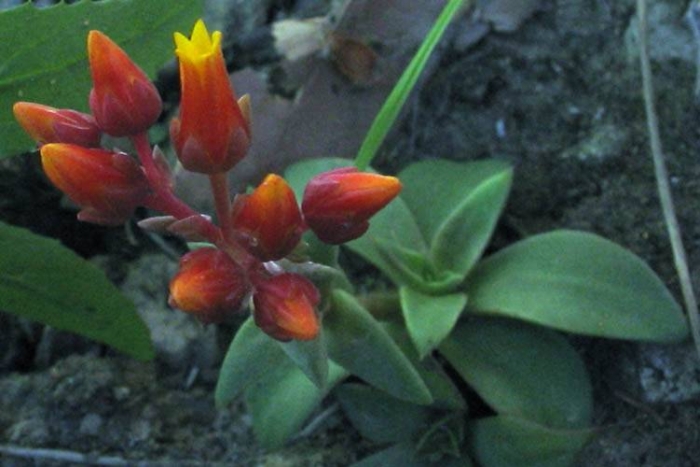Lanceleaf Liveforever
(Dudleya lanceolata)
Lanceleaf Liveforever (Dudleya lanceolata)
/
/

Unknown authorUnknown author
Public domain
Image By:
Unknown authorUnknown author
Recorded By:
Copyright:
Public domain
Copyright Notice:
Photo by: Unknown authorUnknown author | License Type: Public domain | License URL: https://creativecommons.org/public-domain/ | Uploader: Stickpen | Publisher: Wikimedia Commons | Title: Dudleyalanceolata.jpg | Notes: == {{int:filedesc}} == {{Information |Description=Family: Acanthaceae Dyschoriste oblongifolia |Source=[http://www.flickr.com/photos/dejeuxx/4765597204/ Oblongleaf Twin Flower] |Date=2010-05-31 20:45 |Author=[http://www.flickr.com/people/11014423@N07 ... |























































Estimated Native Range
Summary
Dudleya lanceolata, commonly known as Lanceleaf Liveforever, is an evergreen succulent native to the coastal bluffs and rocky outcrops of California and Northwestern Mexico. This perennial herb typically forms dense rosettes of fleshy, lanceolate leaves that can range in color from glaucous green to reddish-purple, depending on sun exposure and water stress. It produces inflorescences up to 18 inches tall, with flowers that have red, orange, or less commonly yellow petals. The flowering season extends from April to July, with the blooms being particularly attractive to pollinators such as hummingbirds and bees.
Lanceleaf Liveforever is valued for its drought tolerance and architectural form, making it a popular choice for rock gardens, succulent collections, and as a potted specimen. It thrives in full sun, requiring very low amounts of water once established, and prefers well-draining soils to prevent root rot. While it is relatively low-maintenance, it can be susceptible to aphids and mealybugs. Overwatering is a common issue in cultivation, so it is crucial to ensure proper drainage and avoid excessive moisture. Dudleya lanceolata is also appreciated for its ability to adapt to coastal conditions and its use in native plant landscaping, contributing to habitat restoration and xeriscaping projects.CC BY-SA 4.0
Lanceleaf Liveforever is valued for its drought tolerance and architectural form, making it a popular choice for rock gardens, succulent collections, and as a potted specimen. It thrives in full sun, requiring very low amounts of water once established, and prefers well-draining soils to prevent root rot. While it is relatively low-maintenance, it can be susceptible to aphids and mealybugs. Overwatering is a common issue in cultivation, so it is crucial to ensure proper drainage and avoid excessive moisture. Dudleya lanceolata is also appreciated for its ability to adapt to coastal conditions and its use in native plant landscaping, contributing to habitat restoration and xeriscaping projects.CC BY-SA 4.0
Plant Description
- Plant Type: Herb, Succulent
- Height: 0.7-1 feet
- Width: 0.7-1 feet
- Growth Rate: Slow
- Flower Color: Orange, Red, Yellow
- Flowering Season: Spring, Summer
- Leaf Retention: Evergreen
Growth Requirements
- Sun: Full Sun
- Water: Very Low
- Drainage: Fast
Common Uses
Bee Garden, Bird Garden, Butterfly Garden, Drought Tolerant, Fire Resistant, Groundcover, Hummingbird Garden, Low Maintenance, Potted Plant, Rock Garden, Salt Tolerant, Showy Flowers
Natural Habitat
Native to the coastal bluffs and rocky outcrops of California and Northwestern Mexico
Other Names
Common Names: Lance-Leaved Dudleya
Scientific Names: , Dudleya lanceolata, Dudleya cymosa subsp. minor, Dudleya elongata, Dudleya lurida, Dudleya hallii, Dudleya brauntonii, Cotyledon lanceolata, Echeveria lanceolata, Dudleya minor
GBIF Accepted Name: Dudleya lanceolata (Nutt.) Britton & Rose